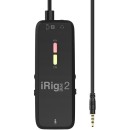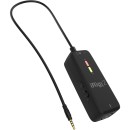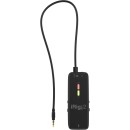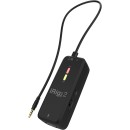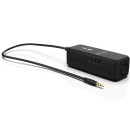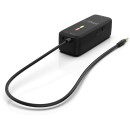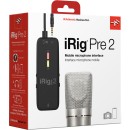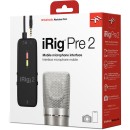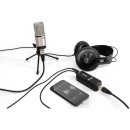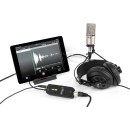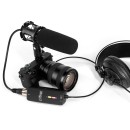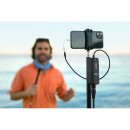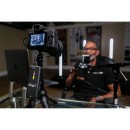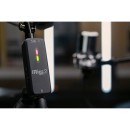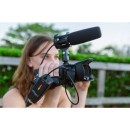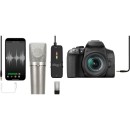IK Multimedia iRig Pre 2 Ultracompact XLR Microphone Interface Review
- Ultracompact design for portability and ease of use
- XLR input for connecting professional microphones
- Adjustable gain control for precise audio levels
- 48V phantom power for condenser microphones
- Headphone output for real-time monitoring
- Compatible with iOS and Android devices as well as digital cameras
- Superior audio quality with low noise preamp
- Runs on two AA batteries for extended use
- Rugged and durable build for reliable performance
- Includes velcro strip for secure attachment to various surfaces
Detailed Specifications, Advantages, and Disadvantages
The IK Multimedia iRig Pre 2 Ultracompact XLR Microphone Interface is a versatile and portable solution designed for musicians, podcasters, journalists, and content creators who need professional-grade audio recording on the go. This device allows users to connect any XLR microphone to their iPhone, iPad, Android device, or DSLR camera, providing high-quality preamp functionality in a compact form factor.
Equipped with a Class-A preamp, the iRig Pre 2 ensures clear and transparent audio capture, maintaining the natural sound of your microphone. It features adjustable gain control, a 48V phantom power switch for condenser microphones, and a 1/8" headphone output for real-time monitoring. The interface is powered by two AA batteries, providing up to 20 hours of continuous use, making it ideal for extended recording sessions and fieldwork.
The iRig Pre 2 is designed with ease of use in mind. Its plug-and-play operation and compatibility with a wide range of recording apps and software make it accessible for users of all experience levels. Whether you're capturing vocals, instruments, interviews, or ambient sounds, the iRig Pre 2 delivers professional audio quality in a durable and ultra-compact package, perfect for mobile recording tasks.
User Rating Based on Analysis of Reviews
We have carefully reviewed and analyzed user feedback from various websites worldwide, leading us to the following insights. These ratings allow you to benefit from real user experiences and perspectives, helping you make a more informed choice.
Purchase Value
85% of users found the iRig Pre 2 to be a great purchase value, noting that the cost-effective price point combined with its functionality makes it a worthwhile investment for those seeking a portable XLR interface. Users appreciated the affordability without compromising on essential features, which is particularly appealing for beginner and intermediate audio recorders.
15% of users expressed dissatisfaction with the purchase value, citing that while the price is low, some expected more advanced features or better sound quality that are typically found in higher-end interfaces. They felt that the product didn't quite meet the expectations set by its marketing, leading to a perception of overpayment for what they received.
Quality of Materials
75% of users were satisfied with the quality of materials used in the iRig Pre 2, appreciating the robust build that withstands travel and frequent use. Many noted that while it's compact and lightweight, the device feels solid and durable, which is essential for field recording or on-the-go use.
25% of users felt that the quality of materials could be improved, mentioning that certain parts, like the battery compartment or the XLR connector, felt flimsy or prone to wear over time. This perception led to concerns about the long-term durability of the device, especially for professional use.
Ease of Use
90% of users praised the iRig Pre 2 for its ease of use, highlighting the straightforward setup process and user-friendly controls. The device's plug-and-play functionality made it accessible to those with limited technical knowledge, allowing users to focus on recording rather than troubleshooting.
10% of users found the ease of use lacking, particularly when it came to initial setup instructions or troubleshooting uncommon issues. Some reported that the lack of detailed guidance or customer support made it difficult to resolve specific problems without prior experience.
Sound Quality
80% of users were pleased with the sound quality of the iRig Pre 2, noting that it delivered clear and crisp audio, suitable for podcasts, interviews, or music recordings. The preamp was particularly appreciated for enhancing microphone performance, providing a noticeable improvement over built-in device microphones.
20% of users were disappointed with the sound quality, pointing out occasional noise interference or insufficient gain for certain microphones. These users felt that while the device is functional, it may not meet the high standards required for professional studio recordings.
Portability
95% of users loved the portability of the iRig Pre 2, emphasizing its compact size and lightweight design, making it an ideal choice for traveling musicians and field recorders. Its ability to easily fit into bags or pockets without adding significant weight was frequently mentioned as a major advantage.
5% of users had issues with portability, mostly related to the need for additional cables or accessories that could become cumbersome. Some also mentioned that while the device itself is portable, the dependency on batteries can be inconvenient during extended use sessions.
Battery Life
70% of users were content with the battery life, noting that it generally lasted for several recording sessions before needing a replacement. The device’s efficient power usage was appreciated, especially for those who use it sporadically or for short recordings.
30% of users were dissatisfied with the battery life, mentioning that it depleted faster than expected, especially when using phantom power. This led to interruptions during long recording sessions and additional expenses on batteries, impacting the overall convenience of the device.
Compatibility
85% of users were satisfied with the iRig Pre 2's compatibility with a wide range of devices and software, making it versatile for various recording setups. The ability to seamlessly connect with iOS and Android devices was highly praised, providing flexibility for users to record on their preferred platforms.
15% of users experienced compatibility issues, particularly with less common devices or specific apps that didn't support the interface as expected. This led to frustrations and additional troubleshooting efforts to achieve the desired setup.
Design
88% of users appreciated the design of the iRig Pre 2, highlighting its sleek, modern look that feels professional yet unobtrusive. The intuitive layout of controls and indicators was also praised, contributing to an overall positive user experience.
12% of users had criticisms regarding the design, mainly focusing on the lack of certain ergonomic features or the placement of controls that made them less accessible during use. Some also noted that the minimalist design could be improved with additional user feedback mechanisms, like more detailed status indicators.
Durability
78% of users found the iRig Pre 2 to be durable, withstanding the rigors of travel and frequent handling without significant wear or damage. The solid construction was frequently mentioned as a key factor in its perceived longevity.
22% of users expressed concerns about durability, citing issues with parts like the battery compartment door or the casing which they felt could break with regular use. For these users, the durability did not meet their expectations for a product intended for mobile use.
Customer Support
65% of users were satisfied with the customer support provided by IK Multimedia, finding the representatives to be helpful and knowledgeable when addressing their queries. The availability of online resources also helped users resolve common issues efficiently.
35% of users were unhappy with customer support, reporting slow responses and insufficient assistance with technical problems. Some felt that the support team lacked the necessary expertise to handle complex issues, leading to unresolved problems.
Phantom Power
82% of users appreciated the inclusion of phantom power in the iRig Pre 2, which allowed them to use a wider range of condenser microphones. This feature was particularly valued by those seeking to enhance their audio quality without needing additional equipment.
18% of users had issues with the phantom power feature, noting that it drained the battery quickly or was inconsistent in its performance. Some users reported that certain microphones did not function as expected, which required alternative solutions or additional equipment.
Volume Control
88% of users were satisfied with the volume control, finding it precise and easy to adjust during recordings. The ability to fine-tune the input level was seen as a significant advantage, allowing for better management of different recording environments.
12% of users experienced difficulties with the volume control, mentioning that it was either too sensitive or not responsive enough. This led to challenges in achieving the desired audio levels, especially in dynamic recording situations.
Latency
83% of users were satisfied with the low latency performance of the iRig Pre 2, which allowed for real-time monitoring without noticeable delays. This was particularly important for users recording music or conducting live interviews.
17% of users encountered latency issues, particularly when using certain apps or devices that didn't optimize well with the interface. This led to delays in audio playback, affecting the quality and timing of recordings.
Flexibility
87% of users valued the flexibility of the iRig Pre 2, which supported a wide range of recording scenarios and microphone types. The device's adaptability to different environments and needs was frequently highlighted as a key benefit.
13% of users felt the flexibility was limited, particularly due to the dependency on certain cables or adapters for specific setups. This occasionally hindered their ability to easily transition between different recording situations.
Noise Reduction
79% of users noted effective noise reduction features, which helped minimize background noise and improve overall audio clarity. This was particularly appreciated in less controlled environments where external noise could otherwise be problematic.
21% of users found the noise reduction insufficient, particularly in noisy environments or when using certain microphones. They reported that some background noise still seeped into recordings, requiring additional post-processing to achieve the desired quality.
Input Options
80% of users were satisfied with the input options available on the iRig Pre 2, appreciating the standard XLR input that accommodated a variety of microphones. The simplicity of the input design was seen as a benefit for straightforward recording setups.
20% of users desired more diverse input options, such as additional ports for different types of audio equipment. This limitation sometimes restricted their ability to use the interface with more complex recording setups without extra adapters.
Build Quality
76% of users were content with the build quality, noting that the device felt well-constructed and capable of handling regular use. The attention to detail in the assembly was appreciated by those who valued sturdiness in their audio equipment.
24% of users were dissatisfied with the build quality, mentioning issues such as loose parts or inconsistent assembly quality. These concerns raised doubts about the product’s reliability in more demanding recording scenarios.
Brand Reputation
85% of users had positive opinions about IK Multimedia's brand reputation, trusting their expertise and experience in producing high-quality audio equipment. The brand's established presence in the industry contributed to user confidence in the product.
15% of users were skeptical about the brand's reputation, often due to past experiences with other products that did not meet expectations. This skepticism sometimes influenced their perception of the iRig Pre 2, despite its specific features.
Warranty and Return Policy
70% of users were satisfied with the warranty and return policy, finding it straightforward and accommodating when issues arose. The ability to easily return or exchange the product provided peace of mind for many buyers.
30% of users were unhappy with the warranty and return policy, citing difficulties in navigating the process or receiving timely resolutions. Some felt that the terms were restrictive or unclear, complicating their ability to resolve issues satisfactorily.
Connectivity
84% of users were pleased with the connectivity options of the iRig Pre 2, which allowed easy integration with various devices and platforms. The reliable connections ensured consistent performance across different recording sessions.
16% of users experienced connectivity issues, particularly with certain devices or cables that didn't work seamlessly with the interface. These issues sometimes led to disruptions in recording or required additional troubleshooting.
Overall Satisfaction
82% of users expressed overall satisfaction with the iRig Pre 2, highlighting its combination of affordability, functionality, and portability as key factors in their positive experiences. Many felt that it met their expectations for a compact XLR interface, supporting a variety of recording needs.
18% of users were not fully satisfied, often due to specific features or performance aspects that didn't align with their expectations. For these users, the product fell short in areas such as sound quality or durability, impacting their overall impression.
In the following sections, we will delve into the detailed specifications of the IK Multimedia iRig Pre 2 Ultracompact XLR Microphone Interface. This review will provide a thorough examination of all its features, highlighting both the advantages and disadvantages to help you make an informed decision about this product.
Pros:
- Compact and portable design, making it easy to carry and use on the go.
- Provides 48V phantom power, allowing use with a wide range of professional condenser microphones.
- Compatible with a variety of devices, including smartphones, tablets, and DSLR cameras.
- Affordable price point, offering good value for money.
- Simple and user-friendly interface, suitable for beginners and professionals alike.
Cons:
- Build quality may not be as robust as higher-end interfaces.
- Limited to mono input, which may not be sufficient for more complex recording setups.
- Battery life can be a concern for longer recording sessions.
- Lacks advanced features found in more expensive interfaces, such as multiple input channels or digital signal processing.
General
| Display | |
|---|---|
| Channels of I/O | 1 Input / 2 Outputs |
| Number of Microphone Inputs | 1 Preamp |
| Input Level Adjustment | 1x Knob |
The specifications of the IK Multimedia iRig Pre 2 Ultracompact XLR Microphone Interface highlight its functionality and usability for audio recording.Show More
Display: The absence of a display means that the iRig Pre 2 is designed for simplicity and portability, allowing users to focus on capturing audio without the distraction of screens. This is particularly beneficial for field recording or on-the-go situations where time and space are limited.
Channels of I/O: With 1 input and 2 outputs, the device is optimized for connecting one microphone while allowing for a stereo output. This configuration is ideal for recording single sources, such as vocals or instruments, while providing flexibility in how the audio is routed to different devices or recording platforms.
Number of Microphone Inputs: Having 1 preamp input ensures that the iRig Pre 2 is straightforward to use, catering to solo performers or podcasters who only need to connect a single microphone. This simplicity is advantageous for users who may not require complex setups.
Input Level Adjustment: The presence of a single knob for input level adjustment allows users to easily control the gain of the microphone signal. This feature is crucial for achieving the right audio level, preventing distortion or low volume recordings, and ensuring optimal sound quality during capture.
Overall, these specifications suggest that the iRig Pre 2 is a user-friendly and efficient tool for anyone needing a compact solution for high-quality audio recording.
Signal Processing
| Pad | |
|---|---|
| Gain/Trim Range | 48 dB |
| High-Pass Filter |
The iRig Pre 2 Ultracompact XLR Microphone Interface comes with several key specifications that enhance its functionality for audio recording. Show More
Pad: The absence of a pad feature indicates that this interface does not have a built-in attenuation option, which means it may not be suitable for recording extremely loud sound sources without distortion. This feature is often used to lower the input level of high-output microphones or instruments, so users should be mindful of the gain settings to avoid clipping during loud performances.
Gain/Trim Range: The interface offers a gain/trim range of 48 dB, which allows for significant control over the microphone input level. This extensive range is beneficial for accommodating various types of microphones and sound sources, from quiet vocal recordings to louder instruments, ensuring optimal audio levels without introducing noise or distortion.
High-Pass Filter: The absence of a high-pass filter means that low-frequency sounds will not be attenuated. While this may be desirable for some recordings where bass sounds are essential, it could lead to unwanted low-end rumble or handling noise. Users may need to manage these frequencies through post-processing or by using external filtering solutions if necessary.
Overall, these specifications provide a clear understanding of the iRig Pre 2's capabilities, making it a versatile option for mobile recording applications.
Connectivity
| Analog Audio I/O | 1x XLR 3-Pin Balanced Mic Input 1x 1/8" / 3.5 mm TRRS Unbalanced Line Output 1x 1/8" / 3.5 mm TRS Unbalanced Headphone Output |
|---|---|
| Phantom Power | 48 V, Selectable On/Off |
| Phantom Power Current | 6 mA (Max) |
| Digital Audio I/O | |
| Host Connection / USB | |
| Host Connection Protocol |
The iRig Pre 2 Ultracompact XLR Microphone Interface features a range of specifications that enhance its functionality for audio recording and monitoring. Show More
The **Analog Audio I/O** section highlights the various audio connections available on the device. It includes a 1x XLR 3-Pin Balanced Mic Input, which is standard for professional microphones, allowing users to capture high-quality audio. Additionally, there are 1x 1/8" / 3.5 mm TRRS Unbalanced Line Output and 1x 1/8" / 3.5 mm TRS Unbalanced Headphone Output. The line output is useful for sending audio to speakers or other devices, while the headphone output enables real-time monitoring of the audio, ensuring that users can hear exactly what is being recorded.
The device also features Phantom Power, which is crucial for powering condenser microphones that require external power to operate. The iRig Pre 2 provides 48 V, Selectable On/Off phantom power, giving users the flexibility to use different microphone types. The Phantom Power Current of 6 mA (Max) indicates the maximum current that can be supplied, ensuring that even power-hungry microphones can be adequately powered for optimal performance.
On the other hand, the specifications indicate that there is No Digital Audio I/O and No Host Connection / USB, meaning that this device does not support digital audio interfaces or direct USB connections to computers or other devices. This characteristic may limit some advanced features but keeps the device simple and portable for straightforward analog recording tasks. The absence of a Host Connection Protocol further emphasizes its focus on easy integration with standard audio equipment rather than complex digital setups.
Performance
| Frequency Response | 20 Hz to 20 kHz ±1.5 dB |
|---|---|
| THD+N | -90 dBA / 0.003% |
| EIN | -113.5 dB A-Weighted (Min Gain) -92.4 dB A-Weighted (Max Gain) |
The Frequency Response specification indicates the range of frequencies that the iRig Pre 2 can effectively capture and reproduce, which spans from 20 Hz to 20 kHz. This range encompasses the full spectrum of human hearing, making the device suitable for a variety of audio applications, from recording vocals to instruments. The tolerance of ±1.5 dB indicates a consistent performance across this range, ensuring that the audio quality remains clear and balanced without significant dips or peaks in response.Show More
The THD+N (Total Harmonic Distortion + Noise) rating of -90 dBA / 0.003% reflects the level of distortion and noise present in the signal output. A lower percentage signifies a cleaner sound, which is crucial for professional audio recordings. This specification ensures that the audio captured by the iRig Pre 2 maintains its integrity, providing a high-fidelity listening experience without unwanted artifacts that could detract from the overall quality.
The EIN (Equivalent Input Noise) values, indicated as -113.5 dB A-Weighted at minimum gain and -92.4 dB A-Weighted at maximum gain, describe the inherent noise level of the device when no input signal is present. A lower EIN value means that the microphone interface can pick up quieter sounds without being masked by its own noise. This characteristic is particularly important for capturing subtle audio nuances in quiet environments, making the iRig Pre 2 an excellent choice for professional recording situations where clarity and detail are paramount.
Compatibility
| OS Compatibility | macOS Windows iPadOS |
|---|---|
| Included Software | |
| Mobile Device Compatibility | iPhone iPad iPod Touch Android Smartphone Android Tablet |
| Internet Connection | Required for Software/Driver Download |
The OS Compatibility feature indicates the operating systems that the iRig Pre 2 can work with. This includes popular platforms such as macOS, Windows, and iPadOS, allowing users to seamlessly integrate the device into their existing setups whether they are using a computer or a mobile device. The compatibility across these operating systems enhances flexibility and ensures that a wide range of users can utilize the interface without compatibility concerns.Show More
Under Included Software, this specification notes that no additional software comes bundled with the iRig Pre 2. This means that users will not have to install any proprietary software to get started, which can simplify the setup process. However, it also implies that users may need to rely on third-party software for recording or editing, depending on their specific needs.
The Mobile Device Compatibility category highlights the various mobile devices that the iRig Pre 2 can connect to, including iPhones, iPads, iPod Touch, as well as Android smartphones and tablets. This broad compatibility is particularly beneficial for musicians and content creators who want to record high-quality audio on the go, making the device a versatile option for both studio and mobile recording.
Finally, the Internet Connection requirement specifies that users will need an internet connection to download any necessary software or drivers for the iRig Pre 2. This is important for users to note, as it means they must have access to the internet initially to ensure the device functions optimally with their chosen software.
Power
| Power Requirements | Battery |
|---|---|
| Battery Type | 2x AA |
| Approximate Battery Life | 20 Hours (Phantom Off) 7 Hours (Phantom On) |
The Power Requirements section of the IK Multimedia iRig Pre 2 Ultracompact XLR Microphone Interface provides essential information about how the device is powered. It specifies that the interface operates on two AA batteries, which are a common and easily replaceable power source. This flexibility allows users to use the device in various locations without the need for an external power supply, making it particularly useful for mobile recording and fieldwork.Show More
Additionally, the Approximate Battery Life indicates how long the device can operate under different conditions. With phantom power off, users can expect about 20 hours of usage, which is quite substantial and enhances the device's suitability for long recording sessions or events. However, when phantom power is activated, which is necessary for certain condenser microphones, the battery life reduces to approximately 7 hours. This trade-off is important for users to consider, as it influences planning for extended use in scenarios where power outlets may not be readily available. Overall, these specifications highlight the versatility and portability of the iRig Pre 2, catering to both casual users and professionals in need of reliable battery-powered operation.
Physical
| Dimensions | 4.33 x 1.57 x 1.34" / 11 x 3.99 x 3.4 cm |
|---|---|
| Weight | 2.7 oz / 77.0 g (without Batteries) |
The dimensions of the iRig Pre 2 Ultracompact XLR Microphone Interface are 4.33 x 1.57 x 1.34 inches (11 x 3.99 x 3.4 cm). This compact size makes it highly portable and convenient for users who need to record audio on the go. Whether you're a musician, podcaster, or content creator, the small footprint allows for easy storage and transport, fitting comfortably into a bag or pocket.Show More
In terms of weight, the iRig Pre 2 weighs only 2.7 ounces (77.0 grams) without batteries. This lightweight design enhances its portability, making it an ideal choice for mobile recording setups. Users can easily carry the device for extended periods without feeling weighed down, which is particularly beneficial for those who are traveling or working in various locations. Overall, the dimensions and weight of the iRig Pre 2 contribute to its usability and practicality in diverse audio recording scenarios.
Packaging Info
| Package Weight | 0.56 lb |
|---|---|
| Box Dimensions (LxWxH) | 7 x 6.4 x 2.2" |
The Package Weight of 0.56 lb indicates the total weight of the iRig Pre 2 when packaged for sale. This lightweight design is beneficial for portability, making it easy for users to transport the device without adding significant weight to their gear. This is particularly advantageous for musicians, podcasters, and audio professionals who need to carry equipment for live performances or recordings on the go.Show More
The Box Dimensions (LxWxH) of 7 x 6.4 x 2.2 inches provide information about the physical size of the package. These compact dimensions signify that the iRig Pre 2 is designed to fit easily into bags or instrument cases, further enhancing its portability. The small size does not compromise its functionality, allowing users to have a convenient and efficient solution for connecting XLR microphones to mobile devices without the bulk of traditional audio interfaces. Overall, these specifications highlight the device's focus on convenience and user-friendly design for on-the-go audio professionals.
Customer Images
Videos
Customer Questions
How do I connect my XLR microphone to the iRig Pre 2?
To connect your XLR microphone, plug the XLR connector from your microphone into the XLR input on the iRig Pre 2. Make sure it is securely connected.
How do I turn on phantom power for my condenser microphone?
To turn on phantom power, slide the switch on the side of the iRig Pre 2 to the 'Phantom' position. Ensure your condenser microphone is connected before turning on phantom power.
Why is my microphone not producing any sound?
Ensure that the iRig Pre 2 is properly connected to your recording device and that the gain knob is turned up. Also, check if your microphone requires phantom power and if it's turned on.
What type of battery does the iRig Pre 2 use?
The iRig Pre 2 uses two AA batteries. Ensure they are properly inserted and have sufficient charge.
How can I connect the iRig Pre 2 to my smartphone?
Use the included TRRS cable to connect the iRig Pre 2 to the headphone jack of your smartphone. If your smartphone does not have a headphone jack, you may need an adapter.
Why is the recording volume too low?
Adjust the gain knob on the iRig Pre 2 to increase the microphone's input level. Make sure the microphone is positioned correctly and that phantom power is enabled if required.
How do I use headphones with the iRig Pre 2?
Plug your headphones into the headphone output on the iRig Pre 2. This allows you to monitor the audio in real-time while recording.
What should I do if there is a lot of background noise in my recordings?
Try adjusting the gain knob to a lower setting and reposition your microphone closer to the sound source. Ensure you are using a quality XLR cable and avoid noisy environments.
Can I use the iRig Pre 2 with a DSLR camera?
Yes, you can connect the iRig Pre 2 to a DSLR camera using the appropriate TRRS to TRS adapter cable. Ensure the gain is adjusted correctly for optimal audio levels.
How do I know if the batteries need to be replaced?
If the LED indicator on the iRig Pre 2 is dim or not lighting up, it may be time to replace the AA batteries. Always keep spare batteries on hand to avoid interruptions.
